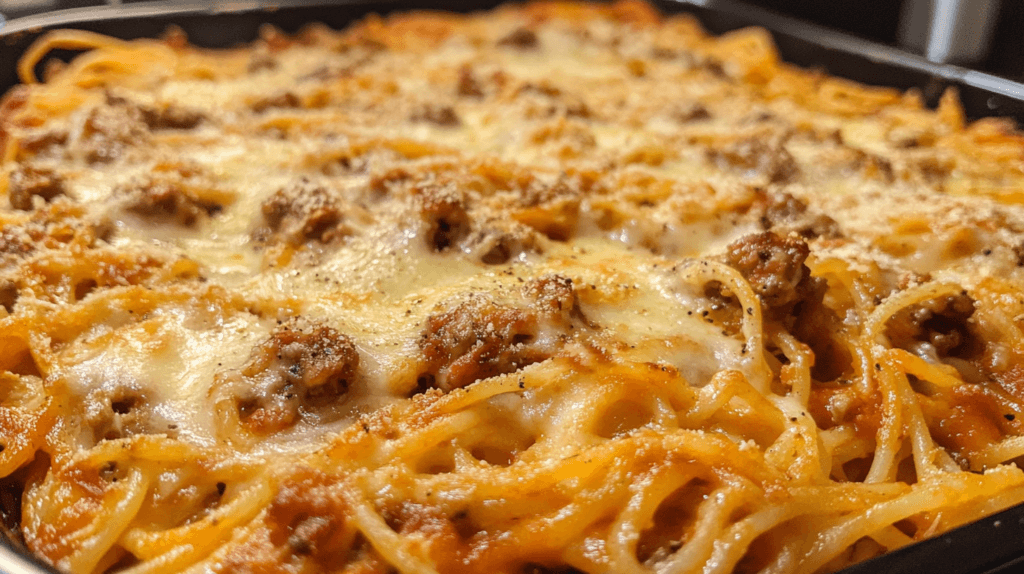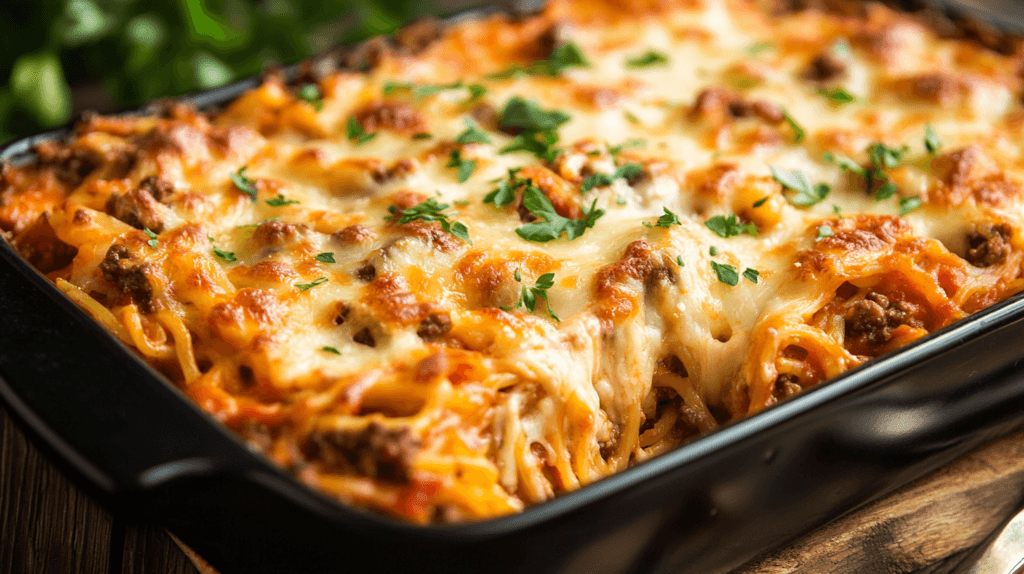Table of Contents
Introduction
Why Spaghetti Casserole is a Comfort Food Favorite
Spaghetti casserole recipe combines the timeless appeal of pasta with a hearty, baked twist that’s sure to warm your soul. This dish is beloved for its comforting layers of savory sauce, melted cheese, and perfectly cooked noodles, making it a go-to for family dinners and special occasions alike. It’s simple to prepare, budget-friendly, and endlessly customizable to suit any taste preferences.
The Perfect Dish for Gatherings and Leftovers
Ideal for feeding a crowd, spaghetti casserole is a star at potlucks, holiday gatherings, and casual dinner parties. The recipe yields generous portions, and leftovers reheat beautifully, ensuring a satisfying meal the next day. Whether you’re planning a weeknight dinner or prepping for an event, this dish delivers on flavor and convenience every time.
Ingredients Overview
Choosing the Right Pasta for Casseroles
Selecting the ideal pasta is crucial for creating a perfect spaghetti casserole. Opt for sturdy noodles like spaghetti, linguine, or even fettuccine, which hold their shape well during baking. For an extra twist, you can substitute traditional pasta with whole wheat or gluten-free options to cater to dietary preferences.
Key Ingredients: Ground Meat, Tomato Sauce, and Cheese
The foundation of any great spaghetti casserole includes:
- Ground Meat: Beef, turkey, or sausage adds hearty flavor and protein.
- Tomato Sauce: Use a rich, flavorful marinara or make your own for a personal touch.
- Cheese: Layers of mozzarella and parmesan create the gooey, golden top that everyone loves.
These ingredients come together to deliver the savory, comforting essence of the dish.
Optional Add-ins: Vegetables, Herbs, and Spices
Take your casserole to the next level with customizable additions:
- Vegetables: Mushrooms, bell peppers, or zucchini add flavor and nutrition.
- Herbs: Fresh basil, parsley, or oregano enhance the aroma and taste.
- Spices: A pinch of red pepper flakes or Italian seasoning can elevate the dish with a hint of complexity.
These optional ingredients allow you to tailor the recipe to suit your family’s tastes or use up items already in your pantry.
Kitchen Tools Needed
Basic Tools: Casserole Dish, Skillet, and Mixing Bowls
To prepare a delicious spaghetti casserole, you’ll need a few essential kitchen tools:
- Casserole Dish: A sturdy, oven-safe dish is vital for baking and serving the casserole.
- Skillet: Perfect for browning ground meat and sautéing vegetables.
- Mixing Bowls: Use these to combine pasta, sauce, and other ingredients before layering them in the dish.
These basic tools ensure a smooth and efficient cooking process.
Optional Tools: Cheese Grater and Pasta Strainer
While not strictly necessary, these additional tools can make preparation even easier:
- Cheese Grater: Freshly grated cheese melts better and enhances the overall flavor.
- Pasta Strainer: Draining cooked pasta efficiently ensures the perfect texture for your casserole.
Having these optional tools on hand can save time and improve the final result of your spaghetti casserole.

Ingredients List
For the Pasta
- 12 oz spaghetti (cooked & drained)
- 1 tablespoon olive oil (to prevent sticking)
For the Meat Sauce
- 1 lb ground beef (or Italian sausage)
- ½ onion (chopped)
- 3 cloves garlic (minced)
- 1 (24 oz) jar spaghetti sauce
- 1 teaspoon Italian seasoning
- ½ teaspoon salt
- ½ teaspoon black pepper
- ¼ teaspoon red pepper flakes (optional)
For the Cheese Layers
- 1 cup ricotta or cottage cheese
- ½ cup sour cream
- 1 egg (beaten)
- 2 cups shredded mozzarella cheese
- ½ cup grated Parmesan cheese
Preparing the Pasta
Cooking Pasta to Al Dente for Perfect Texture
To achieve the perfect spaghetti casserole, cooking the pasta to al dente is crucial. This ensures the noodles maintain their structure during baking and don’t become overly soft. Follow these steps:
- Bring a large pot of salted water to a rolling boil.
- Add the pasta and stir occasionally to prevent sticking.
- Cook for 1-2 minutes less than the package instructions, as the pasta will finish cooking in the oven.
- Drain the pasta and rinse briefly with cool water to halt the cooking process.
This method results in pasta with the ideal texture for layering into your casserole.
Tips for Choosing Spaghetti Varieties
The type of pasta you choose can subtly affect the dish:
- Traditional Spaghetti: Classic and reliable for this recipe.
- Whole Wheat or Gluten-Free: Excellent for dietary considerations.
- Thicker Noodles (e.g., Linguine): Great for a heartier version of the casserole.
Each variety brings its own texture and flavor, so feel free to experiment based on your preferences.
Making the Meat Sauce
Combining Ground Beef or Sausage with Tomatoes
The meat sauce is the heart of any spaghetti casserole. Here’s how to prepare it:
- In a large skillet, brown your choice of ground beef, turkey, or sausage over medium heat.
- Drain excess fat for a lighter sauce, if desired.
- Stir in tomato sauce or crushed tomatoes and bring the mixture to a gentle simmer.
- Adjust seasoning with salt and pepper to taste.
The result is a rich and savory base that ties the dish together.
Enhancing Flavor with Garlic, Onions, and Italian Seasoning
For a robust and aromatic sauce, incorporate these ingredients:
- Garlic: Sauté minced garlic in olive oil for a fragrant start.
- Onions: Add diced onions to the skillet, cooking until translucent.
- Italian Seasoning: A blend of dried basil, oregano, and thyme adds depth and classic Italian flavors.
These enhancements elevate the sauce, making it flavorful enough to stand out in the final casserole.
Preparing the Cheese Layer
Best Cheeses for Spaghetti Casserole
Cheese is the star ingredient that gives spaghetti casserole its gooey, creamy texture and rich flavor. The best cheeses for this dish include:
- Mozzarella: Melts beautifully and provides a stretchy, gooey texture.
- Ricotta: Adds creaminess and a mild, smooth flavor.
- Parmesan: Offers a sharp, nutty taste that enhances the dish.
These cheeses work together to create a harmonious blend of flavors and textures.
Mixing Ricotta, Mozzarella, and Parmesan for Creaminess
To prepare the cheese layer:
- Combine ricotta, shredded mozzarella, and grated parmesan in a mixing bowl.
- Add a beaten egg to the mixture to help it set during baking.
- Season lightly with salt, pepper, and a pinch of Italian seasoning for extra flavor.
This mixture will create a creamy layer that complements the savory meat sauce and pasta.
Layering the Casserole
Creating Layers for Balanced Flavors
Building the casserole in layers ensures each bite is packed with flavor. Follow these steps:
- Start with a thin layer of sauce on the bottom of the casserole dish to prevent sticking.
- Add a layer of cooked pasta, spreading it evenly.
- Spoon over a generous layer of meat sauce.
- Spread the cheese mixture evenly on top of the sauce.
- Repeat these layers until all ingredients are used, finishing with a top layer of sauce and shredded mozzarella.
This method ensures a balanced distribution of flavors throughout the dish.
Top Layer Tips for a Crispy, Golden Finish
To achieve a perfect top layer:
- Sprinkle a final layer of shredded mozzarella and a light dusting of grated parmesan over the casserole.
- Bake uncovered for the last 10 minutes to allow the cheese to bubble and brown.
- For an extra-crispy finish, broil for 2-3 minutes while keeping a close eye to prevent burning.
This crispy, golden top adds a satisfying texture and visual appeal to the casserole.
Baking the Casserole
Ideal Oven Temperature and Cooking Time
To bake your spaghetti casserole to perfection:
- Preheat the oven to 375°F (190°C).
- Cover the casserole dish with foil to prevent the top from browning too quickly.
- Bake for 25-30 minutes, ensuring all layers are heated through.
- Remove the foil and bake for an additional 10-15 minutes, allowing the cheese to melt and turn golden brown.
This process ensures the casserole is evenly cooked while maintaining a deliciously crispy top layer.
How to Achieve a Perfectly Melted Cheese Top
To create a beautifully melted and golden cheese topping:
- Use a combination of shredded mozzarella and grated parmesan for a blend of textures and flavors.
- Bake uncovered for the last few minutes, allowing the cheese to bubble and brown.
- For a more pronounced crispy texture, use the broiler for 2-3 minutes at the end of baking, keeping a close watch to avoid burning.
The result is a visually appealing and flavorful crust that enhances the overall dish.

Variations to Try
Vegetarian Option: Replacing Meat with Veggies
For a vegetarian-friendly casserole:
- Swap ground meat with diced vegetables like zucchini, mushrooms, bell peppers, or spinach.
- Sauté the veggies with garlic, onions, and Italian seasoning to build rich flavors.
- Layer them with the pasta, sauce, and cheese for a hearty, meat-free version.
This option is perfect for vegetarians or those looking for a lighter dish.
Adding Heat: Spicy Italian Sausage or Red Pepper Flakes
If you enjoy a little spice, consider these additions:
- Replace ground beef with spicy Italian sausage for a bold, flavorful kick.
- Sprinkle crushed red pepper flakes into the sauce for a subtle, warming heat.
These tweaks add depth and excitement to the traditional recipe.
Gourmet Touch: Fresh Basil and Sun-Dried Tomatoes
Elevate your casserole with gourmet ingredients:
- Add fresh basil leaves between the layers for a burst of herby freshness.
- Include chopped sun-dried tomatoes to introduce a tangy, umami-rich note.
These simple upgrades transform the casserole into a refined, restaurant-worthy dish.
Serving Suggestions
Pairing Ideas: Garlic Bread and Salad
Enhance your spaghetti casserole meal with these perfect pairings:
- Garlic Bread: The buttery, garlicky crunch complements the rich casserole. Serve it warm for the ultimate comfort food combo.
- Fresh Salad: A crisp, refreshing green salad with a tangy vinaigrette balances the casserole’s richness. Add cucumbers, cherry tomatoes, and shredded carrots for variety.
These accompaniments turn a simple dinner into a memorable dining experience.
Creative Uses for Leftovers: Lunch or Meal Prep
Leftover spaghetti casserole is versatile and easy to repurpose:
- Lunch: Pack individual portions in microwave-safe containers for a quick, satisfying meal at work or school.
- Meal Prep: Divide the casserole into freezer-safe portions to enjoy throughout the week. It reheats well and retains its flavor and texture.
Leftovers make busy days more manageable without sacrificing a delicious, home-cooked taste.
Tips for Storing Leftovers
Freezing and Reheating Spaghetti Casserole
Spaghetti casserole freezes and reheats beautifully, making it a practical choice for meal prep:
- To Freeze: Cool the casserole completely, then wrap it tightly in plastic wrap and aluminum foil. Alternatively, store it in an airtight freezer-safe container.
- Reheating from Frozen: Thaw overnight in the refrigerator, then bake at 375°F (190°C) for 20-25 minutes, covered with foil. Remove the foil for the last few minutes to re-crisp the top.
Proper freezing preserves the flavors and textures, ensuring the dish tastes as good as the day it was made.
How Long Can It Be Stored Safely?
- Refrigeration: Leftover spaghetti casserole can be stored in the refrigerator for up to 4 days in an airtight container.
- Freezing: For longer storage, freeze the casserole for up to 3 months.
Following these guidelines ensures your leftovers remain safe to eat while retaining their delicious flavor.
Common Mistakes to Avoid
Overcooking Pasta: Maintaining Al Dente Texture
One of the most common mistakes when making spaghetti casserole is overcooking the pasta. To ensure the noodles hold their shape and don’t turn mushy during baking:
- Cook pasta to al dente, meaning it should still have a slight bite.
- Drain and rinse briefly with cool water to stop the cooking process.
- Remember that the pasta will continue to cook in the oven, so slightly undercooked noodles work best.
Avoiding overcooked pasta keeps the casserole from becoming overly soft or soggy.
Overloading on Sauce or Cheese
While sauce and cheese are essential, too much of either can overwhelm the dish:
- Sauce: Excess sauce can make the casserole watery. Use just enough to coat the pasta and keep the layers moist.
- Cheese: Overloading cheese may cause an overly rich dish with an unbalanced flavor. Stick to recommended amounts for each layer to achieve a perfect balance.
Moderation ensures a harmonious blend of all ingredients, making every bite enjoyable.
Nutritional Insights
Balancing Indulgence with Healthy Substitutions
Spaghetti casserole is a comfort food, but you can make healthier choices without sacrificing flavor:
- Use whole wheat or gluten-free pasta for added fiber or to meet dietary needs.
- Replace ground beef with ground turkey or a plant-based meat alternative to reduce fat content.
- Add extra vegetables, like spinach, zucchini, or mushrooms, to boost nutrients and cut calories.
These simple swaps create a dish that’s indulgent yet balanced.
Calculating Calories and Macronutrients
For those mindful of their diet, understanding the casserole’s nutritional breakdown is helpful:
- Calories: The total calorie count depends on portion size and ingredients like meat, cheese, and sauce.
- Macronutrients: A typical serving is high in carbohydrates (from pasta), protein (from meat and cheese), and fats (from cheese and oil).
- Use apps or tools to calculate the nutritional value based on your specific recipe and substitutions.
Balancing indulgence with thoughtful adjustments allows you to enjoy spaghetti casserole while maintaining your health goals.
FAQs About Spaghetti Casserole Recipe
What is the secret to the best spaghetti?
The secret to the best spaghetti lies in balancing flavors and textures. Cook the pasta to al dente, use a high-quality tomato sauce or homemade marinara, and incorporate fresh ingredients like garlic, onions, and herbs. Adding freshly grated parmesan or a drizzle of olive oil before serving enhances the flavor. For casseroles, layering the ingredients evenly ensures each bite is delicious.
What’s the difference between lasagna and baked spaghetti?
While both are baked pasta dishes, the main differences are:
- Shape: Lasagna uses flat pasta sheets, while baked spaghetti typically uses long, thin noodles like spaghetti or linguine.
- Layering: Lasagna is layered with pasta, sauce, and cheese in distinct layers, whereas baked spaghetti is often mixed together and topped with cheese.
- Texture: Lasagna has a firmer structure, while baked spaghetti is creamier and more casual in presentation.
What do you put in spaghetti to make it taste good?
To elevate the flavor of spaghetti:
- Fresh Garlic and Onions: Sautéed in olive oil, they create a flavorful base.
- Herbs: Fresh basil, parsley, or oregano add aromatic depth.
- Cheese: Parmesan or pecorino romano enhances the dish with a salty, nutty flavor.
- Extras: A splash of red wine, crushed red pepper flakes, or a sprinkle of lemon zest can brighten the dish.
What to put on spaghetti besides sauce?
If you’re looking for alternatives to traditional spaghetti sauce, consider:
- Olive Oil and Garlic: A light and flavorful option.
- Pesto: Adds a nutty, herby flavor.
- Alfredo Sauce: For a creamy, indulgent dish.
- Vegetables: Sautéed veggies like zucchini, spinach, or mushrooms can create a simple topping.
What to add to store-bought spaghetti sauce to make it taste homemade?
Enhance store-bought sauce with these additions:
- Fresh Garlic and Onions: Sauté them before adding the sauce.
- Herbs and Spices: Basil, oregano, thyme, or a bay leaf can deepen the flavor.
- Meat or Veggies: Browned ground meat or sautéed vegetables add texture and taste.
- Splash of Red Wine: Adds richness and complexity.
- Sugar or Honey: Balances the acidity of the tomatoes.
These tweaks make store-bought sauce taste as if it was simmered from scratch.
What sauce is the same as spaghetti sauce?
Spaghetti sauce is often used interchangeably with marinara sauce, a simple tomato-based sauce seasoned with garlic, onions, and herbs. Other similar sauces include:
- Pomodoro Sauce: A lighter, fresher tomato sauce.
- Bolognese: A meat-based sauce that’s heartier and richer.
- Arrabbiata: A spicy tomato sauce made with chili peppers.
Each sauce offers a unique twist while still complementing spaghetti perfectly.
Conclusion
Recap of Recipe Steps
Spaghetti casserole is a timeless dish that combines comfort, flavor, and simplicity. Here’s a quick recap of the steps:
- Cook the pasta to al dente for the ideal texture.
- Prepare a flavorful meat sauce using ground meat, tomato sauce, and seasonings.
- Mix a creamy cheese layer with ricotta, mozzarella, and parmesan.
- Layer the casserole with pasta, sauce, and cheese for a balanced bite in every forkful.
- Bake to perfection, achieving a golden, bubbly cheese top.
With these straightforward steps, you’ll create a dish that’s both satisfying and crowd-pleasing.
Encouragement to Customize and Enjoy
One of the best things about spaghetti casserole is its versatility. Whether you prefer a vegetarian version with sautéed veggies, a spicy twist with Italian sausage, or a gourmet touch with fresh basil and sun-dried tomatoes, the possibilities are endless. Feel free to experiment and make it your own.
To enrich this recipe, explore these related dishes on Titan Recipes:
- Try a hearty twist with this Beefaroni Recipe.
- Pair your casserole with a refreshing Broccoli Pasta Recipe.
- Add a creamy element using this Cheesy Rice Recipe.
Serve it to loved ones, savor the flavors, and enjoy the satisfaction of crafting a hearty, homemade meal that’s perfect for any occasion. Happy cooking!


